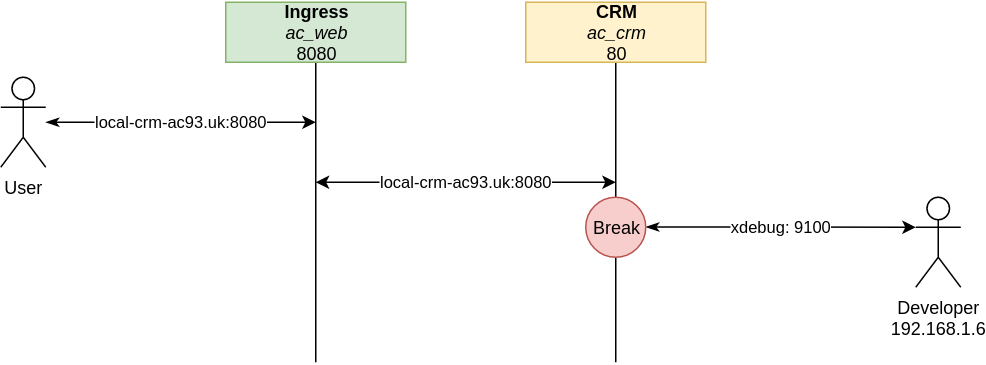I plan on creating a new and improved post in Q1 2021 which has similar end-goal to this post.
TL;DR:
- All PHP apps running in a single container on port 8080, debugging is sometimes hard.
This can’t go on, I need xDebug to work properly!
- Make a base image for all apps to use, isolating each application into its own container.
- Make an
nginxreverse proxy to route requests to the relevant container. - For each application, from the base image make a new service with a bespoke configuration.
Ahh, debugging is nicer now!* repo

Motivation
Improve document quality in 4 minutes with Architectural decision records
This is a great idea to clarify technical decisions. As covers, we document code religiously. The reasoning behind the processes and solutions, not so much.
So many times I’ve looked at code (usually my own) and wondered what the thinking was behind doing something a certain way.
Colleague
Rationale
For some time I’ve been developing using one container to host ALL our (PHP) code for our services, which consists of 3 main projects:
- Core CRM System
- API
- Members Area
It’s all bundled into a php:7-apache container with some extra things. It works fine, but there’s one main reason I was looking to separate things out: debugging.
Debugging Core CRM System was fine, it’s where we spend most of our development time, and somewhere around 70% of the time it’s not a problem to debug because it’s standalone.
If we want to debug something where we use the Members platform which goes through the API and ultimately to the CRM it plays havoc.
I’ve spent a lot of time searching, but the requests just hang. Yes I know Postman, etc. exist, no, I don’t want to mock requests, etc. everything I tried in PHPStorm, VS Code didn’t seem to work nicely. I had to change the setup because I can’t go back to var_dump and echo debugging!
nginx
We’ll start with nginx. This will act as the only ingress point (on port 8080) for our applications. It will act as a reverse proxy to the relevant (isolated) container where the app lives. We can do this based on the server name, e.g.:
local-crm.ac93.ukrequests are handled by the app inac_crmcontainer.local-api.ac93.ukrequests are handled by the app inac_apicontainer.local-mem.ac93.ukrequests are handled by the app inac_memcontainer.- everything else in
ac_misccontainer.
We’ll have a config:
containers/ingress/sites.conf:/etc/nginx/conf.d/site.conf:
server {
listen 80;
server_name local-crm.ac93.uk;
location / {
proxy_pass http://ac_crm;
proxy_set_header Host $host:8080;
proxy_set_header X-Forwarded-For $proxy_add_x_forwarded_for;
}
}
server {
listen 80;
server_name local-api.ac93.uk;
location / {
proxy_pass http://ac_api;
proxy_set_header Host $host:8080;
proxy_set_header X-Forwarded-For $proxy_add_x_forwarded_for;
}
}
server {
listen 80;
server_name local-mem.ac93.uk;
server_name local-vip-mem.ac93.uk;
location / {
proxy_pass http://ac_mem;
proxy_set_header Host $host:8080;
proxy_set_header X-Forwarded-For $proxy_add_x_forwarded_for;
}
}
# everything else
server {
listen 80 default_server;
location / {
proxy_pass http://ac_misc;
proxy_set_header Host $host:8080;
proxy_set_header X-Forwarded-For $proxy_add_x_forwarded_for;
}
}
A couple things to mention here:
- The
proxy_passis using thecontainer_namefor the desired container/service to handle that request depending on theserver_nameof the request. - You’ll see I’m using
proxy_set_headerHost $host:8080, there are some variables available to you such as$server_portand$remote_portbut I couldn’t get them to work, I think using$remote_portwould send me back incremented number on each request, but your mileage may vary.
This service in docker-compose.yml:
web:
image: nginx:alpine
container_name: ac_web
ports:
- "8080:80"
volumes:
- "./containers/reverse-proxy/site.conf:/etc/nginx/conf.d/site.conf"
depends_on:
- ac-crm
- ac-api
- ac-mem
- ac_misc
networks:
ac:
ipv4_address: 172.1.1.101
Networks are important, I’ll mention that in more detail in the next couple of services.
Why do you need to go proxy to httpd instances I hear you cry? Why don’t you use php:fpm and configure them as needed?
Our applications have multisite configuration, so certain things need to change depending on the URLs. In httpd virtual host configs we are setting environment variable depending on the URL, e.g.:
<VirtualHost *:80>
ServerName local-mem.ac93.uk
ServerAlias local-vip-mem.ac93.co.uk
SetEnvIf Host "local-mem.ac93.uk" MULTISITE=standard
SetEnvIf Host "local-vip-mem.ac93.uk" MULTISITE=vip
ProxyPreserveHost On
<Directory /var/www/html/laravel-app/public>
Options -Indexes
# etc.
</Directory>
</VirtualHost>
We could do this in nginx but I’m not familiar with its configuration. My brief research led me to if is evil and pretty sure setting environment variables isn’t as elegant.
Base PHP Image
We’ll use base php:7.3-apache container with extra things installed, like xdebug, memcache, composer, Docker in Docker (don’t judge, it’s development only!) etc.
containers/web-base/Dockerfile:
FROM php:7.3-apache
# install some essential stuff, mostly for composer and general utilities for managing apps
RUN rm -rf /var/lib/apt/lists/partial && rm -rf /var/lib/apt/lists/*
RUN apt-get update -o Acquire::BrokenProxy="true" -o Acquire::http::No-Cache="true" -o Acquire::http::Pipeline-Depth="0" --fix-missing
RUN apt-get install -o Acquire::BrokenProxy="true" -o Acquire::http::No-Cache="true" -o Acquire::http::Pipeline-Depth="0" -y \
zip \
unzip \
apt-utils \
nano \
curl \
pv \
git \
libzip-dev \
zlibc \
zlib1g \
libmemcached-dev \
netcat \
libmagickwand-dev
# install php extensions
RUN docker-php-ext-configure zip --with-libzip
RUN docker-php-ext-install zip
RUN pecl install \
igbinary-3.0.1 \
msgpack-2.0.3 \
imagick-3.4.4 \
memcached-3.1.3 \
xdebug-2.7.2
RUN docker-php-ext-enable \
memcached \
imagick \
xdebug
RUN docker-php-ext-install \
pdo \
pdo_mysql
#RUN echo "extension=memcached.so" >> /usr/local/etc/php/conf.d/memcached.ini
RUN . /etc/apache2/envvars
RUN a2enmod rewrite
RUN a2enmod proxy_http
RUN usermod -u 1000 www-data
# https://github.com/docker-library/php/issues/344#issuecomment-364843883
COPY --from=composer:latest /usr/bin/composer /usr/bin/composer
COPY --from=docker:latest /usr/local/bin/docker /usr/local/bin/docker
It’s a bit bloated, it’s bundled for ease of development and not for lightweight production instances, so bear this in mind.
Docker in Docker is a requirement for our complicated test setup. Maybe I’ll write about this another time.
We basically use this image for our 3 projects, and mount volumes. Mostly php configs, httpd configs, and our source code.
CRM
So our CRM is the guts of the business.
As mentioned above, it’s going to use the base image we mentioned earlier. We’re going to mount the code to the container, along with bespoke configuration.
Here is the CRM service in docker-compose.yml:
ac-crm:
build:
context: ./containers/base
image: ac_web_base:latest
container_name: ac_crm
env_file:
- ./containers/.env
volumes:
- "/var/run/docker.sock:/var/run/docker.sock"
- "./containers/crm/httpd/crm.conf:/etc/apache2/sites-enabled/crm.conf"
- "./containers/crm/php/crm.ini:/usr/local/etc/php/conf.d/99-crm.ini"
- "./html/crm:/var/www/html/crm"
networks:
ac:
ipv4_address: 172.1.1.102
build and context are for the base image earlier. If it’s not built then it will be soon, and given the name in image. The subsequent services (api and members area) refer to the image name too, so it will be reused.
env_file is common stuff used in all application services, it’s not really essential for this article, but we have DB info in there. I’m omitting database stuff for simplicity here.
volumes:
- The first in is for Docker in Docker, this is not essential.
- The second entry in is the bespoke configuration for
httpdvirtual host. - The third entry in is the bespoke configuration for PHP (mostly XDebug).
- The fourth entry is our code.
Apache Config
Just a relatively straightforward config.
Note that ProxyPreserveHost is On, this is required for the request to get sent back correctly to the client. This is the proxy_set_header Host $host:8080; part in the ingress service.
The file containers/crm/httpd/crm.conf will look something like this:
<VirtualHost *:80>
ServerName local-crm.ac93.uk
DocumentRoot /var/www/html/crm
ErrorLog ${APACHE_LOG_DIR}/error.log
CustomLog ${APACHE_LOG_DIR}/access.log combined
ProxyPreserveHost On
<Directory /var/www/html/crm>
Options -Indexes
</Directory>
</VirtualHost>
PHP Config
The file containers/crm/php/crm.ini will look something like this:
[global]
; https://github.com/docker-library/php/issues/212#issuecomment-204817907
log_errors = On
error_log = /dev/stderr
error_reporting = E_ALL
display_errors = stderr
xdebug.remote_enable=1
xdebug.remote_handler=dbgp
xdebug.remote_port=9100
xdebug.remote_autostart=1
xdebug.remote_host=192.168.1.6
So the flow sort of looks like this:

Unfortunately for each project you will need to update the remote_host to the IP of your host machine where your debugger is running.
API
Here is the API service in docker-compose.yml:
ac-api:
build:
context: ./containers/base
image: ac_web_base:latest
container_name: ac_api
env_file:
- ./containers/.env
volumes:
- "./containers/api/httpd/api.conf:/etc/apache2/sites-enabled/api.conf"
- "./containers/api/php/api.ini:/usr/local/etc/php/conf.d/api.ini"
- "./html/api:/var/www/html/api"
depends_on:
- ac-crm
networks:
ac:
ipv4_address: 172.1.1.103
extra_hosts:
- "local-crm.ac93.uk:172.1.1.102"
This looks familiar by now.
Main thing to note here is that there is an extra section; extra_hosts. We need this because our API can call our CRMs API, so it needs to know how to find the CRM.
The virtual host setup is much the same, containers/api/httpd/api.conf:
<VirtualHost *:80>
ServerName local-api.ac93.uk
DocumentRoot /var/www/html/api
ErrorLog ${APACHE_LOG_DIR}/error.log
CustomLog ${APACHE_LOG_DIR}/access.log combined
ProxyPreserveHost On
<Directory /var/www/html/api>
Options -Indexes
</Directory>
</VirtualHost>
Same thing with the php config, only thing really changing is the xdebug.remote_port.
containers/api/php/api.ini:
[global]
; https://github.com/docker-library/php/issues/212#issuecomment-204817907
log_errors = On
error_log = /dev/stderr
error_reporting = E_ALL
display_errors = stderr
xdebug.remote_enable=1
xdebug.remote_handler=dbgp
xdebug.remote_port=9101
xdebug.remote_autostart=1
xdebug.remote_host=192.168.1.6
Members Area
Last piece of the puzzle and there are not many changes here compared to the previous services.
The service in docker-compose.yml:
ac-mem:
build:
context: ./containers/base
image: ac_web_base:latest
container_name: ac_mem
env_file:
- ./containers/.env
volumes:
- "./containers/mem/httpd/mem.conf:/etc/apache2/sites-enabled/mem.conf"
- "./containers/mem/php/mem.ini:/usr/local/etc/php/conf.d/mem.ini"
- "./html/mem:/var/www/html/mem"
depends_on:
- ac-api
networks:
ac:
ipv4_address: 172.1.1.104
extra_hosts:
- "local-api.ac93.uk:172.1.1.103"
Like how the API needs to know how to find the CRM, the Members Area needs to know how to find the API, thanks extra_hosts.
Apache config is very similar containers/mem/httpd/mem.conf:
<VirtualHost *:80>
ServerName local-mem.ac93.uk
ServerAlias local-vip-mem.ac93.uk
DocumentRoot /var/www/html/mem
ErrorLog ${APACHE_LOG_DIR}/error.log
CustomLog ${APACHE_LOG_DIR}/access.log combined
ProxyPreserveHost On
<Directory /var/www/html/mem>
Options -Indexes
</Directory>
</VirtualHost>
Same again with PHP config containers/mem/php/mem.ini:
[global]
; https://github.com/docker-library/php/issues/212#issuecomment-204817907
log_errors = On
error_log = /dev/stderr
error_reporting = E_ALL
display_errors = stderr
xdebug.remote_enable=1
xdebug.remote_handler=dbgp
xdebug.remote_port=9102
xdebug.remote_autostart=1
xdebug.remote_host=192.168.1.6
That’s all for now! I didn’t go into detail about the ac_misc container because it’s the same story. Instructions are below on how to setup the debugger in PHPStorm.

To see a complete example, see the associated github repo https://github.com/alistaircol/docker-nginx-ingress-httpd-php.
Logging
Adventure in logging:
cat >> /etc/hosts <<<EOF
127.0.0.1 graylog
EOF
Setting Up Xdebug

(PHPStorm)
Each project will need to be configured.
Go to File -> Settings -> Language & Frameworks -> PHP
- Set PHP language level/version
- Add a new CLI interpreter
- Select
From Docker, Vagrant, VM, Remote...
- Select

Choose Docker and php:7.3-apache as the image name.


Now we need tell PHPStorm where to find files locally based on the file location on the server.



Go to File -> Settings -> Language & Frameworks -> PHP -> Debug
Set the Debug port to 9100 or whatever it is for your project. Uncheck the two force checkboxes.

Go to File -> Settings -> Language & Frameworks -> PHP -> Servers
Add a new Server and give it a meaningful name.
Set the Host to the IP address on which PHPStorm is running and Port to that which the project XDebug is configured to.

Go to Run -> Edit Configurations.
Add a new PHP Remote Debug configuration.

Check Filter debug connection by IDE Key and select your server.

Run the debug configuration, set a breakpoint and hit it!
